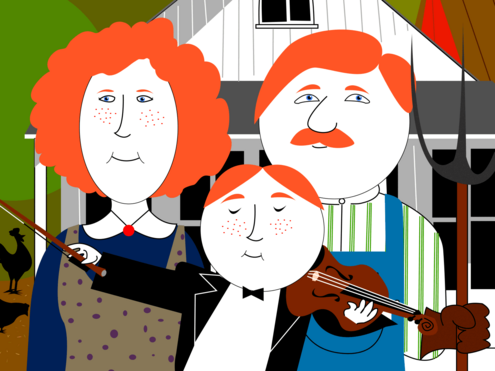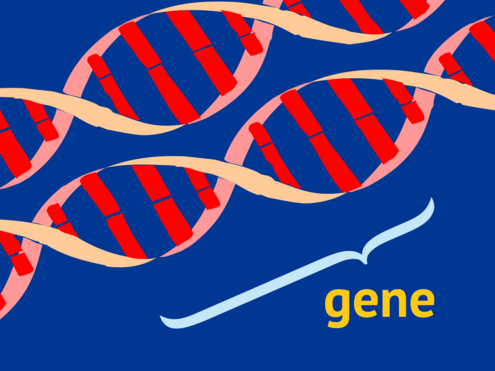- BIG IDEAS -
What is Genetics?
Genetics is the study of how genes and how traits are passed down from one generation to the next. Our genes carry information that affects our health, our appearance, and even our personality!
GENetics is where it all begins.
Some scientists are curious about basic questions of life: Where did it come from? Why is it so varied? Why do children look like their parents?
To answer these questions, they study a type of biology called GENetics (juh-net-icks).
"Gen" means beginning.

Parents pass traits on to their children.
Genetics is the science of genes and how traits are passed on from one generation to the next.
People who study genes are geneticists (juh-net-i-sists).
Every living thing has DNA.
DNA is an amazing chemical present in every cell. It contains all the information cells need to make a fish a fish, or you YOU.

What do all these things have in common? DNA!

DNA, the chemical that tells cells what to do.
All humans start out as a single cell and grow into trillions of cells. DNA tells the single cell to divide into two cells, then four, then eight — until a whole body forms. It controls the growth of EVERYTHING, from your head to your toes.
DNA also influences many individual traits, such as whether you are a boy or a girl and whether you are tall or short.
Genes are made of DNA.
Where do traits, such as eye color and shape, come from? Why do you look more like your relatives than other people? The parts of your cells that determine these traits are called genes.

What color eyes do you have?

What color eyes do your parents have?
In the past, no one knew what genes were. In the 20th century, scientists figured out that they were actually made of DNA.
Genes come in pairs. You get half of your genes from your mother, and the other half from your father.
We gather clues about life by studying genes.
As we discover more about how genes work, we will be able to understand how cells build complex organisms — like humans.
Today, scientists are studying human genes to learn about traits and diseases. There are so many genes in humans — at least 30,000 of them — that it will take a long time to study every one in detail and find out what it does.

Genes carry information. The closer we look, the more we learn.

We will be studying genes for generations to come!
A genome is all the DNA in a cell, including all the genes.
Recently, new technology has enabled scientists to look closely at the entire human genome.

This "PCR" machine copies DNA so that we can study it.

Many fruit fly genes are similar to human genes.
They have also been able to describe the whole genomes of other animals, including those of bacteria, worms, flies, and mice. The science of genomics asks questions about all of these genes at once. Scientists can also compare genomes of different animals and figure out how they are similar and different.
Why isn't the study of genes called genealogy?
Well, the name was already taken.
Genealogy is the study of family origins. It is how people trace their ancestry and create a family tree. It's not a biological science. Genealogy has been around for a long, long, time — before we discovered genes.
The science of genetics began in the 1800s when Gregor Mendel figured out how traits are inherited by studying peas. Since scientists identified genes in the mid-1900s, the field of genetics has grown by leaps and bounds.

In the 1800s, Gregor Mendel discovered the rules of genetics.

Pea plants are how Mendel's genetic studies began.
Image Credits:
red-headed family, courstey of AMNH by Kelvin Chan; ladybug, courtesy of USDA (CC BY 2.0); purple starfish, courtesy of NOAA (CC BY 2.0); rainbow trout, courtesy of NOAA (CC BY 2.0); DNA, courtesy of AMNH; dark colored eye, courtesy of Michael Mims via Unsplash; light colored eye, courtesy of Janko Ferlič via Unsplash; gene illustration, courtesy of AMNH by Kelvin Chan; child at computer, courtesy of AMNH by Jim Steck; PCR machine, courtesy of AMNH; fruit fly, courtesy of Rolf Dietrich Brecher via Flickr (CC BY 2.0); Gregor Mendel courtesy of AMNH; Pea pods, courtesy of AMNH.




 Biodiversity
Biodiversity
 Brain
Brain
 Genetics
Genetics
 Marine BiOLogy
Marine BiOLogy
 MicrobiOLogy
MicrobiOLogy
 PaleontOLogy
PaleontOLogy
 ZoOLogy
ZoOLogy
 AnthropOLogy
AnthropOLogy
 ArchaeOLogy
ArchaeOLogy
 Astronomy
Astronomy
 Climate Change
Climate Change
 Earth
Earth
 Physics
Physics
 Water
Water
